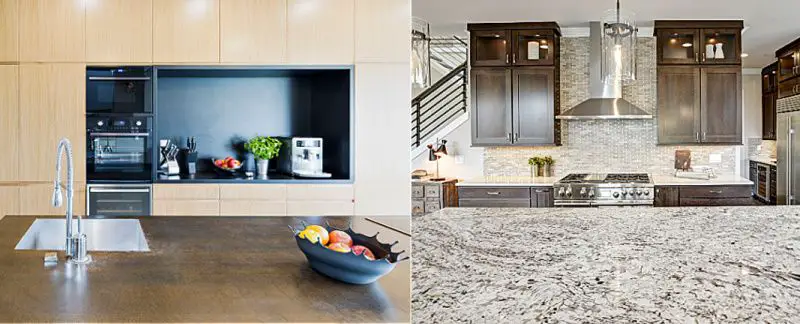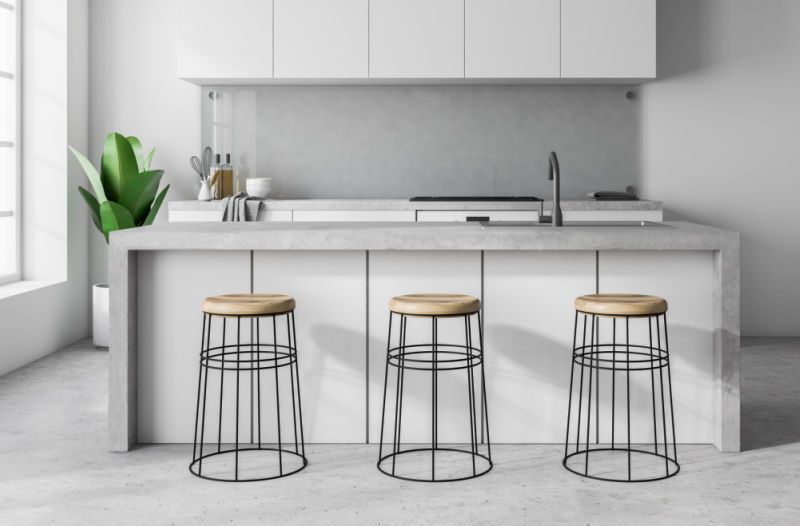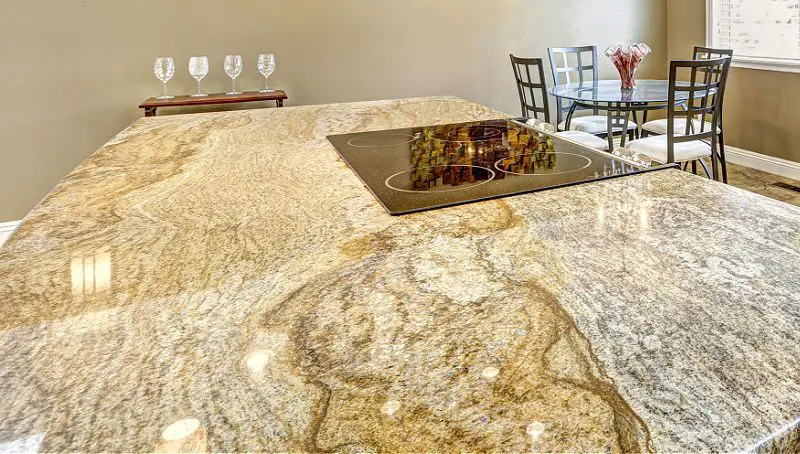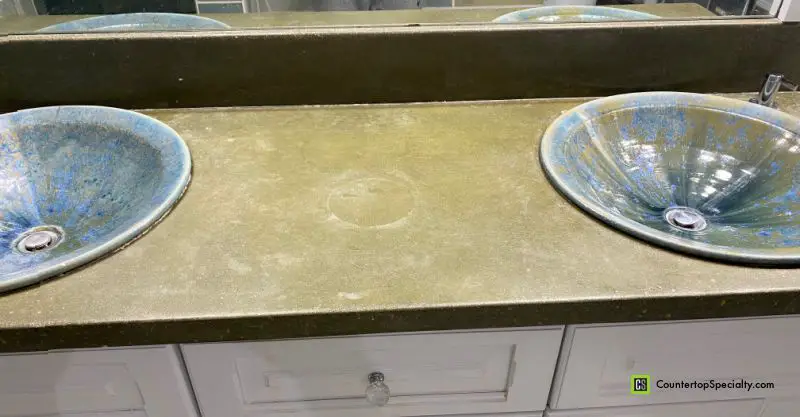Concrete vs Granite Countertops:
A Complete Comparison

Granite countertops have long been customer favorites due to their durability, style choices, easy maintenance, and repair. However, a concrete countertop gives granite a run for the money, owing to its easy customization - allowing imaginative personal designs.
So which material is better? In this guide, we dig deep to compare concrete vs. granite countertops and how they fare against each other.
On This Page
- What is Concrete?
- What is Granite?
- Pros and Cons of Granite and Concrete Countertops
- Cost: Concrete Countertops vs. Granite
- Concrete Vs. Granite: Colors, Finishes, Edges
- Concrete Vs. Granite: Cleaning, Care, and Maintenance
- Ease of Repair Comparison
- Comparing Installation Options
- Concrete vs Granite For Outdoor Kitchen
- Where to Buy Concrete Countertops?
- Frequently Asked Questions
What is Concrete?
Manufacturers make concrete by mixing water, sand, cement, and rock. Variations in the concrete mix allow for customized and original worktops.
A concrete countertop is not boring at all.
From varying colors to the possibility of any shape or finish, this countertop material gives you the freedom to let your creativity shine. With concrete, you can match any design scheme of your choice.
What is Granite?
Granite is a natural stone created when quartz, mica, feldspar, and other minerals are forged under extreme pressure and heat in the earth over millions of years. Granite is found in most parts of the world.
Top consumer magazines have consistently rated granite higher than most other countertop materials. Granite is known for its exceptional durability and vast color options.
Granite has long been a popular choice for a bathroom vanity or kitchen countertops.
Granite is highly heat resistant, does not scratch or etch, and is relatively stain-resistant. Some darker color varieties are practically stain-proof.
The depth and composition of minerals create original patterns that exude classic beauty and luxury.
Pros and Cons of Granite and Concrete Countertops
Now that we know the significant differences between these two types of countertops, let’s take a closer look at the practical advantages and disadvantages.

Concrete Pros and Cons
Pros
- Can take any shape, including curves
- Allows for integrated sinks and drain boards
- Highly customizable with varying colors and embedded objects
- Heat resistant (excluding sealer)
- DIY installation can bring down the cost
- Good for outdoor use
Cons
- Needs a sealer for stain resistance
- Needs periodic wax application to protect the sealer from damage
- Colors (especially epoxy topcoats) can fade and become yellow.
- Not very scratch resistant
- Prone to etching (dull spots and rings from acidic foods and drinks)
- Newly installed countertops can warp or curl with a sudden change in temperature (although this is rare)
Granite Pros & Cons
Even though granite is an excellent countertop material, it has advantages and disadvantages.
Pros
- Naturally unique with more than 2500 colors and patterns available
- Highly durable for heavy use
- Scratch and heat resistant
- Darker colors are stain resistant
- Hygienic
- Easy to clean and repair (when needed)
- Does not etch
- Excellent for outdoor use
Cons
- Most granite requires sealing to prevent stains on most granite colors (but many darker colors do not need sealing)
- Rare colors are expensive
- Visible seams
Cost: Concrete Countertops vs. Granite
Considering concrete countertops vs. granite cost, we find that both concrete and granite countertops are on the expensive side. However, granite can be much cheaper for some colors.
Concrete prices may not be costly material-wise, but professional installation is a hefty expenditure.
- The cost for concrete countertops is anywhere between $70 to $140/ square foot installed.
- Sometimes the one-time fabrication charges are separate from the installation costs, which can be up to $50/hour.
Granite countertop costs are determined more by the rarity and availability of the color chosen.
- Basic granite colors can cost $35 per square foot installed for granite.
- The average cost is $45 - $65 per square foot.
- Rare granite colors, special installation, and complex fabrication can cost anywhere from $80 to $125+ - even to $200 psf in some cases.
Concrete Vs. Granite: Colors, Finishes, Edges
Both concrete and granite countertops offer numerous design choices. However, concrete allows for more creative customization.
Color
Myriad concrete countertop colors are achieved by adding pigments and chemical stains while mixing the concrete or after the installation.
With concrete, you can mimic the look, feel, and texture of natural stone countertops or engineered stone to a degree if you like, but it always retains the distinctive look of concrete.
However, creating an exact color is challenging as the dyes tend to get lighter as the concrete cures in the following weeks and months after installation.
Waxing or applying a concrete sealer or epoxy coatings allows for a high-gloss finish, but the wax is not heat resistant.
On the other hand, it is nearly impossible to match the number of color and pattern choices available with natural stone granite countertops.
Granite color options exceed 2500 variations and allow you to match your countertops with any color scheme.
Choose from deep reds to sandy browns, pale pink to bright white, blacks, greens, and blues, and a wide range of surface patterns that generally display a grainy or pebbled look.

However, the pebbled or coarse grain appearance can be uniform throughout the countertop or vary in density or “movement.”
“Movement” refers to non-uniform patterns with changes in color, saturation, and shapes across the surface that creates an undulating or flowing pattern.
Thus, you can always find a granite color to complement your kitchen design.
Finishes
Granite and concrete have multiple finish options, but concrete is more customizable.
Concrete countertops are made from scratch, so you can choose any finish you like - from smooth to textured to hand-crafted. You can opt for any of the following finishing options with concrete.
- Polished/ Sanded Finish: This gives a smooth finish that can be low on shine or high gloss, depending on the amount of polishing.
- Veined Finish: This imitates marble or granite. You can use pre-packaged mixes, contrasting colors, or make voids into the concrete surface to fill with colored grout later.
- Hand Troweled Finish: This allows you to match a natural stone appearance closely, as the finish can vary from smooth to rough, exhibiting different color streaks and patches.
- Wood-Grained Finish: This finish mimics wood by using wood-grained form liners or those lined with actual wood.
- Exposed-Aggregate Finish: This dramatic finish is achieved by exposing the colored stone or glass pieces seeded within the concrete through a grinder.
- Embedded Objects: Concrete counters offer the unique ability to embed any object you like into the surface for a one-of-a-kind personalized design.
Granite finishes do not offer the uber customization of concrete. However, the several types available generally satisfy most buyers.
- Polished Finish: This finish is created on industrial machines that grind and smooth the surface to a gloss, not by applying a polishing product. Polishing improves the color depth and vibrancy, enhances intricate details, and increases stain resistance by closing pores (some varieties may still require a sealer). It is also easy to clean such surfaces.
- Honed Finish: Even though smooth, a honed finish is a bit muted compared to a polished finish. It’s a matte finish with a slight sheen and less color saturation. It does not have as much stain resistance and shows fingerprints on darker colors.
- Leathered Finish: A leathered finish is a popular textured finish to add a dash of visual interest. It requires more effort to clean and maintain and is not as easily repaired or refinished as a honed or polished finish.
- Flamed Finish: This is a dramatic textured finish usually used only on floors, walls, or outdoors. This finish is impractical for kitchen and bathroom countertops since cleaning requires much more effort. It is made by blowing off minerals in granite by exposing them to a blow torch or high flame.
Edges
For concrete countertop edges, you can add a finishing touch by using various custom edge forms (available on Amazon) to create a variety of edges styles like these:
- Roped
- Vined
- Stone
- Bullnose
- Live edge
Concrete kitchen countertop fabricators use rubber, plastic, or foam molds. And concrete countertops can be made with thick or thinner edges.
Granite edge styles are plentiful, from simple to extra fancy and complex. Some may require an additional piece of granite laminated to the slab to create the thick elaborate design.
- Square
- Eased
- Bevel
- Quirk
- Mitered edge
- Ogee
- Bullnose
- Demi bullnose
- DuPont
Keep in mind that for both countertops materials, the fancier the edge, the more expensive.
Concrete Vs. Granite: Cleaning, Care, and Maintenance
Concrete countertops are prone to staining and require sealing. Only apply an impregnating sealer and wax for a highly polished finish, but you can use a topical sealer for a textured finish.
Note that you may need to reapply the sealer every few years.
Regularly apply this quality beeswax (available on Amazon) to protect the sealer. Overall, concrete countertops require more maintenance in comparison to other materials.
Once sealed and waxed, you can clean the concrete with a granite cleaning spray which is best to avoid dull etch marks caused by most common cleaners.
Avoid abrasive cleaners, and don’t use dish soap as a regular cleaner. Dish soap causes a dingy film to build up over time.
Tough and greasy stains can be removed using a poultice. However, etch marks caused by acidic foods require countertop repair.
Related Content:
How To Clean Concrete Countertops
How To Get Stains Out of Concrete Countertops
For granite countertops, stain resistance depends on absorbency. It’s a porous material with some varieties more porous and prone to staining than others.
Applying a granite sealer can control stains.
However, many granite varieties (generally the darker colors) are very dense, are nearly stain-proof, and do not need sealing.
Granite does not etch, and cleaning granite it is super simple. Just use water and a sponge for quick spills.
For deep cleaning and shine maintenance, use a quality granite cleaner along with a topical stone polish.
Ease of Repair Comparison
Repair for most damage is possible with both granite and concrete countertops.
Concrete kitchen countertops can stain, scratch, etch, chip, and crack.

Usually, stains are removable, and etching (dull spots) can be repaired. For etch marks, hone or polish the affected area, and fill it with grout as needed.
You can glue the chipped pieces back on, if available. Alternatively, you can fill chips and cracks with new material - both need to be color-matched.
Filler materials can be silicone or latex caulking polymer-modified, grouts, or epoxies.
Scratches can be touched up with more sealer in spots, or the whole slab can be resealed.
Granite: any pits, chips, and cracks are repaired using Granite and Marble Repair Kits for Pits and Chips.
If you choose a professional for such repairs, they usually use epoxy for granite countertop repairs, but it is almost impossible to match the color. The repair kit solves the color matching problem and is easy to work with on your own.
Stains in granite are removed using a good Granite Stain Remover Poultice. Most spots will come out, but deep or old stains may not.
Comparing Installation Options
Concrete countertop installation prices can be high, but it is a project you can take on with a bit of help from family and friends. Since concrete takes the shape of any mold, it is relatively easy to form any shapes, curved or otherwise, if needed.
You must seal the concrete countertop to improve stain resistance.
However, this DIY project may be too much for you if you are a rookie. Concrete is heavy, and cabinets may need reinforcement, etc. In that case, hire professional help (cost discussed above).
For granite countertop installations, you can go for slabs, tiles, or modular granite - with the last kind giving you the option of DIY installation.
The granite slab can be 2 cm or 3 cm thick - the latter is favored for varying edge designs with natural stone.
Granite tile reduces your costs drastically, but the grout will be visible and prone to chipping and cracking. Granite tiles will also require more care than the average slab.
Modular granite is extra-large tiles or custom-made sections with edges. They are not costly, with the added ease of installation. Even though you save installation money, the color choices and sizes are minimal compared to slabs.
Concrete vs Granite For Outdoor Kitchen
For outdoor countertops, granite is the better choice compared to concrete countertops. Granite is more durable and resistant to damage from heat, scratches, etching, staining, and discoloration from the sun and requires less maintenance than concrete. Granite is a top performer of all outdoor countertop materials.
However, concrete is a viable, solid option for an outdoor countertop, especially if you’d like to install them yourself.
The pros and cons of granite and concrete for outdoor countertops are the same as for an indoor kitchen countertop.
The one additional problem with concrete outdoor countertops is choosing the correct outdoor pigment or concrete stain that won’t be damaged by weather or ultraviolet light from the sun.
Some pigments are now more resistant to UV fading and weather. And you could always forgo applying a dye to sidestep this issue.
Still, granite is superior to concrete countertops for an outdoor kitchen.
Where to Buy Concrete Countertops?
You’ll need to look locally for concrete countertop fabricators. Don’t look for cement countertops, as “cement” is an ingredient in concrete.
Since concrete countertops are hand-made, an artisan in your area will fabricate and install the counters (in most cases).
However, a couple of national companies allow you to order and buy concrete countertops:
As always, be sure to get references and quotes from several fabricators.
Frequently Asked Questions
Are concrete countertops cheaper than granite?
On average, concrete countertops are more expensive than granite. Concrete countertops cost between $70 to $140/ sq. ft. installed. Granite countertops cost around $35 per square foot installed for common colors and $45 to $65/psf on average. However, for rare colors and special installation, granite costs between $80 to $125+ psf.
Can concrete countertops look like granite?
Yes, custom concrete countertops can look like granite with a pebbled, grained, or veined finish. You can also buy prepackaged mixes to create granite-like veining as the countertop is cast.
Is granite stronger than concrete?
While both granite and concrete are durable materials, granite is stronger and harder than concrete. Granite has a compression strength of 19,000 psi and tensile strength of 700 psi (pounds per square inch). In comparison, the strength of concrete is 6200/400 psi. Granite Mohs hardness is 6-7 while concrete is 5. So granite is tougher and easier to maintain. Concrete is much more prone to scratches, cracks, stains, and etching and lacks the extreme heat resistance of granite.


